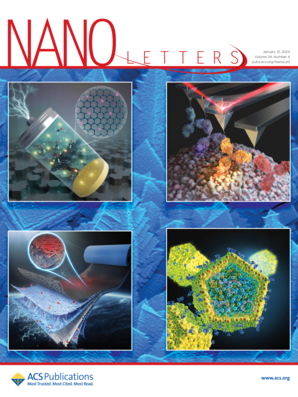Order–Disorder Transition Induced Dynamic Rashba Effect in 2D Halide Perovskites
IF 9.6
1区 材料科学
Q1 CHEMISTRY, MULTIDISCIPLINARY
引用次数: 0
Abstract
Two-dimensional (2D) hybrid organic–inorganic perovskites exhibit pronounced Rashba splitting, positioning them as promising candidates for spintronic applications. However, the underlying mechanism of inversion symmetry breaking and its impact on excitonic optical properties remains elusive. In this study, we investigate a series of 2D Ruddlesden–Popper perovskites and reveal that the order–disorder transition induced by phenyl-based cations triggers a dynamic Rashba effect. At the critical temperature, we observe a reduction in exciton recombination lifetime, an increase in circularly polarized photoluminescence, and a 3-fold enhancement in polarization by constructing a van der Waals heterostructure. Theoretical calculations indicate that local inversion symmetry breaking, driven by the slight displacement of Pb atoms, is the key mechanism underlying the dynamic Rashba effect. These findings establish the dynamic Rashba effect as a critical mechanism governing exciton dynamics, offering valuable insights into advancing spintronic and optoelectronic technologies based on 2D perovskites.

求助全文
约1分钟内获得全文
求助全文
来源期刊

Nano Letters
工程技术-材料科学:综合
CiteScore
16.80
自引率
2.80%
发文量
1182
审稿时长
1.4 months
期刊介绍:
Nano Letters serves as a dynamic platform for promptly disseminating original results in fundamental, applied, and emerging research across all facets of nanoscience and nanotechnology. A pivotal criterion for inclusion within Nano Letters is the convergence of at least two different areas or disciplines, ensuring a rich interdisciplinary scope. The journal is dedicated to fostering exploration in diverse areas, including:
- Experimental and theoretical findings on physical, chemical, and biological phenomena at the nanoscale
- Synthesis, characterization, and processing of organic, inorganic, polymer, and hybrid nanomaterials through physical, chemical, and biological methodologies
- Modeling and simulation of synthetic, assembly, and interaction processes
- Realization of integrated nanostructures and nano-engineered devices exhibiting advanced performance
- Applications of nanoscale materials in living and environmental systems
Nano Letters is committed to advancing and showcasing groundbreaking research that intersects various domains, fostering innovation and collaboration in the ever-evolving field of nanoscience and nanotechnology.
 求助内容:
求助内容: 应助结果提醒方式:
应助结果提醒方式:


